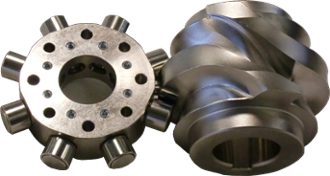Applications of Cam Indexers
No Comments - Leave a Comment
ABOUT CAM INDEXERS

Cam Indexers are used in a multitude of industries and in numerous applications. Their design is optimal for many manufacturing jobs, and they are a critical component in many automated manufacturing systems.
Cam Indexers are best defined as a machine tool positioning device. They carry components in a manufacturing environment with a repeating process of indexing (rotating) around an axis, stopping, dwelling while an operation is performed, then indexing again to repeat the process. What makes a ‘cam indexer’ a cam indexer is that the rotation behavior, that is the rotational acceleration, deceleration, period between stops and dwell times are tightly controlled by the cam configuration.
To learn more about specific types of cams and the resulting cam indexer operation, you can check out our Guide to Rotary Index Tables (Cam Indexers).
Cam Indexers are usually made of precision machined circular steel plates, with one or more spindles, a drive system, encoders, sensors, controllers and slots or mounting holes to hold components. Of course they are also made using very precisely machined cams that are designed by experts to deliver exactly the rotational characteristics needed to meet a specific application.
Learn more about cam indexer cam configurations.
CAM INDEXER APPLICATIONS
One of the only limits to what can be manufactured using a cam indexer is the size of the table, and cam indexers can be quite large depending on where they are used. Cam indexers are most often used to take one piece or part around to different work areas or to orient a piece for different operations. They can move arrays of (often) relatively small parts around work stations for sequential machining, manufacturing, welding, equipment positioning, inspection or assembly tasks. The parts on the cam indexer can be loaded manually, but far more often they are loaded automatically by another assembly line machine, as the goal of using cam indexers is to take steps towards fully automated assembly.
Most cam indexers work with machines that perform fast and simple vertical operations.
These machines include, but are not limited to:
- Industrial presses
- Screwdrivers
- Riveters
- Dispensers
- Pick-and-place units
- Ultrasonic or resistance welders
These machines are an ideal pairing with cam indexers as they can stay in one consistent position for the entire process of manufacturing a product, with the cam indexer bringing every part or product to the perfect position to be modified or assembled. If the timing of these machines are coordinated, their time to assemble a product can be a fraction of that of workers assembling a product. This system is also incredibly efficient as the only moving parts are the motor of the indexing table, the cams and the quick up-and-down cycle of the machines working on the parts, meaning that the only parts that should need maintenance are the drivers of these moving parts.
The best cam indexer manufacturers take great care in delivering long-lasting components ‘where the rubber meets the road’ so to speak. Cams are hardened and ground to extremely tight tolerances and finishes to reduce wear and the change in operating characteristics that would happen if cams became out of the correct shape. Cam followers use long-life sealed bearings and hardened wear surfaces as well to ensure maximum durability of the key operating components.
Industries that use cam indexers include automotive manufacturers, bottling companies, microchip manufacturers and many more. They are invaluable to manufacturers pushing for automation and increased efficiency in their factories, turning work that used to take days into work that takes only hours. If a simple assembly task is required on small parts in a factory, there is no better way to complete the task than by coupling an assembly tool and an indexing table.
Interested in understanding the key engineering decisions that will make sure you get the right cam indexer? Get our guide below!
Comments
No Comments - Leave a Comment

 Translate
Translate